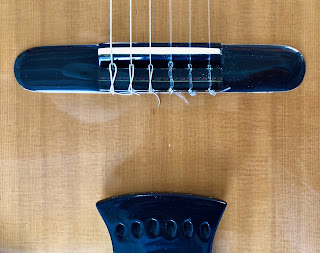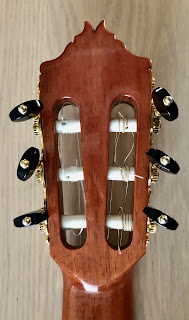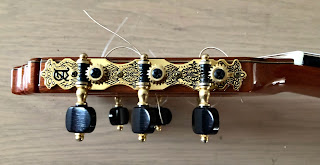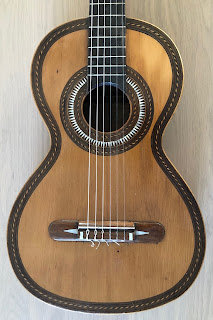Presented here is one of the guitars built by the Renato
Bellucci workshop in Paraguay. He emigrated from Italy
to Paraguay at a young age and developed his skills
on the guitar by following various workshops with
the great players of that time. Interested in the anatomy
of the guitar as an instrument, he started building them.
SOLD.
As a regular player he was keen on developing extra's on the
guitar such as an armrest that really is a useful addition. Another
aspect that immediately draws attention is the tailpiece of
course. That helps to release the bridge from a lot of strain
caused by the tension of the strings and moreover, it changes
the forces that are working on a soundboard in a negative
way. Especially by guitars equipped with a lattice bracing.
The lattice bracing as has been built in this guitar can be
studied here, leaving the soundboard itself quite thin. I had
close contact with the buyer who indeed claims a big
difference when using the violin tailpiece. For me a
reason to try the effect of it on one of my guitars.
And the back of this guitar that is in a pristine condition.
The three layered neck insert is an extra option. No damages
on the back of the head or elsewhere. The own frequency
of the soundbox lies on a Bb which means around 117 Hz.
Each client is able to customize his or her guitar that
begins with the choice of the soundboard, back and sides.
Presented here is the very luxury option: African Blackwood
that adds 1700 USD to the total price being so rare. On
the other hand it makes this instrument quite heavy but
beautiful anyway. As for the heaviness: Most lattice
braced instrument are on the heavy side.
The ornamentation in the middle is another thing that
deserves attention. Very well done.
The label on the contrary to the rest of the guitar is quite
modest. This guitar has been finished on the 23 oktobre
of 2009 and bears number 851.
Closer shot at the armrest and the rounded edge of
the bridge is present here as well. No damages here
but due to the reflections while photographing it
may appear a bit different!
The bridge in combination with the tailpiece that is said to
enhance the volume of a guitar with about 18 %. They
are calling it "Violin Tail". The bridgebone was another
issue on this guitar: Too much play! You can compile your
own guitar by just visiting the mangore.com site but take a
look at the right as the price increases with almost
everything you're adding. The extra's on this guitar:
- Canadian cedar topped guitar
- Sides and back out of African Blackwood
- The 3 reinforcement strips in the neck
- The armrest and tailpiece
- The Lattice bracing of the top
- Rounded edges of the bridge
- The radiused fingerboard
- Extra ornamentation of the soundbox
- Position markers on the side
This guitar would end up being available
for 6.281 USD when ordered new.
The only little nick that separates this guitar from being real mint!
Frets are like new and flattened out evenly and afterwards
crowned and polished of course. Fret ends have been taken
care for. Bellucci could have done this part better. Therefore
I shouldn't buy these guitars in the blind. Too much issues
as e.g. lacquer faults that have been solved now but in fact
shouldn't be there on a guitar in this price range.
The sound has been discussed by others but I can only
speak for this instrument: A very well balanced and
evenly, friendly sounding instrument. Never too harsh.
This guitar also separates nicely and plays very comfortable
though the volume could be better to my opinion. Maybe I
should give the tailpiece a try? On YouTube I'm presenting
this guitar for its' sound and appearance. As for the sound?
Just judge for yourself.
The reinforcement of the neck can be seen here
which is an addition as well. The knobs can be screwed
off and swapped with other examples to your liking.
The scale on this guitar is 650 mm. No fretwear.
The head looks nice and well carved. No comments so
far but the topnut should have been made radiused as well
to fit the also radiused fingerboard. A new and better nut
therefore has been added.
As for the ornamentation. That is where the quality from
this workforce of Renato Bellucci shines. Simply great!
These ornamantions are not only on the front!
Also sides and back have been done.
Good working tuners for effortless tuning. Gotoh brand.
A shot made for the edges of the soundboard as
also there the purling suits the beautiful rosette.
The radiused fingerboard can be studied here and the same
has now been done with the topnut. In fact maybe not necessary
as one could have carved the spaces for the outer strings deeper
but any experienced luthier might be able to tell you that it is
not the way to handle these things.
A beautiful and lovely rosette and contrasts the Canadian
Cedar top and the ebony fingerboard mounted here. On the
sides of the fingerboard where it meets the soundboard the
lacquer was chipped off, possibly by the lacquering process
in a too humid environment or the too thick layers of poly-
urethane finish. It has been cured now.
The tailpiece that can be discussed of course but I think
this luthier has a point. Let's take the earlier Lucien Gelas
guitars into account. The same possibility was created
there. Made out of ebony here to my believe. So some
parts on this guitar are very finely executed but others
would have deserved more attention such as lacquering
work on several spots, a better topnut and bridgebone
and a proper fret leveling and dressing.
Alhambra 8P
The first model in the Concert series, built by the master
craftsmen at Alhambra (Muro de Alcoy) named 8 P.
Cedar topped and with solid rosewood back and sides.
SOLD.
Just one slight damage at the bottom on the right.
I will try to cure this by using hot water / steam.
A nice rosette combined with a rich bridge inlay.
And of course the Logo inlay on the headstock
most likely in mother of pearl.
The axe holders are riveted onto the base plate
of the tuners. A sign of quality most of the time.
Really nice woods are used for back
and sides on this one.
You can even enlarge it to take a closer
look by clicking on the picture.
The tuners again with the Alhambra logo on top.
Superior quality what in fact belongs to a guitar
in this class range.
Gracefully shaped outer heel though that
counts for the inner heel (tongue) as well.
This picture has been taken to show the absolute
minimal fret wear on this guitar. In fact it still
needs to be played in to my opinion. Topnut and
bridgebone have been painstakingly adjusted already.
The inlay of the Alhambra logo.
And the rosette with a look on the label already.
In fact a more plain label as opposed to the ones
used nowadays in their guitars.
The inlay in the string tie block.
The damage (a nick) repaired now. For those who want
to know more about these kind of reparations, it all starts
with a wet towel and a soldering gun to steam out the
damage. Simply varnishing is not the way to go on
a cedar topped guitar. That colors the spot dark. For
me a bit of an experiment as I matched the color of the
soundboard with oil paint and then filled the "gap"
(that already was smaller after the steaming process)
with super glue that becomes really hard and moreover,
as it is aggressive, adheres and even mixes very well
with the original lacquer and/or French polish.
And to be complete: The damage as it came to me.



































































